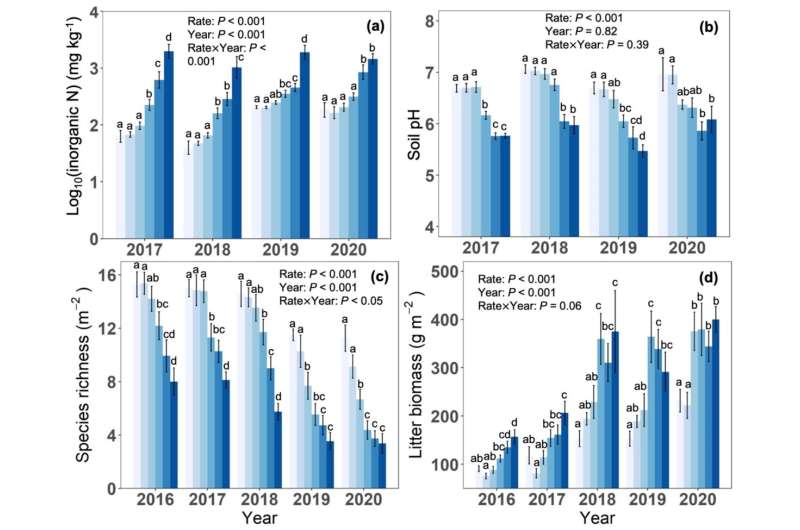This article has been reviewed according to Science X's editorial process and policies. Editors have highlighted the following attributes while ensuring the content's credibility:
fact-checked
peer-reviewed publication
trusted source
proofread
Study finds different nitrogen saturation thresholds in a temperate steppe

Nitrogen saturation refers to the phenomenon that the net primary productivity of an ecosystem—a fundamental ecosystem function and also a measure of carbon (and energy) sequestration by the ecosystem—tends to initially increase with increasing nitrogen input, and then stops increasing after the nitrogen input amount reaches a certain level.
Dr. Lv Xiaotao and Dr. Yang Guojiao from the Institute of Applied Ecology of the Chinese Academy of Sciences found that the nitrogen saturation threshold of aboveground net primary productivity (ANPP) was 13 g N m-2 yr-1, above which ANPP would no longer change with increasing nitrogen input in the temperate steppe.
In addition, belowground net primary productivity (BNPP) also increased, but only when nitrogen input was less than 5 g N m-2 yr-1. Above this threshold, BNPP decreased with increasing nitrogen input.
The researchers, together with researchers from Lancaster University and the Institute of Botany of CAS, have been studying the response of aboveground and belowground components of net primary productivity to nitrogen inputs for years at the Erguna Forest-Steppe Ecotone Research Station (Inner Mongolia).
According to the researchers, the different responses of ANPP and BNPP to nitrogen inputs resulted in a much lower nitrogen saturation threshold (6.7 g N m-2 yr-1) for NPP than that for ANPP, which means that the nitrogen saturation study of ANPP could be misused to calculate the response of NPP to nitrogen deposition.
This is another important scientific finding after the research team found the significant difference between the interannual stability of ANPP and BNPP in response to nitrogen addition. Both findings advance our understanding of the effects of nitrogen inputs on grassland productivity.
The study is published in the journal Global Change Biology.
More information: Guo‐Jiao Yang et al, Different nitrogen saturation thresholds for above‐, below‐, and total net primary productivity in a temperate steppe, Global Change Biology (2023). DOI: 10.1111/gcb.16803
Journal information: Global Change Biology
Provided by Chinese Academy of Sciences



















